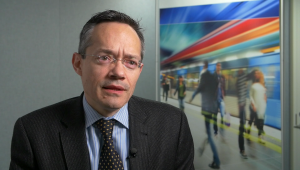By Gary Howe | 17 September 2013
A new dawn is breaking in global health care. Smart mobile technology is poised to lead the transformation, working together with social networking, cloud computing and big data analytics. EY’s Gary Howe explains how.
Look around you. Perhaps you’re reading this article on your commute — or maybe at home or in the office. Wherever you are, chances are you’re not far from a smart mobile device — you may even be reading this on Citizen Today’s mobile app. Market research shows that some 300 million smart phones, tablets and notebooks were shipped worldwide in the first three months of 013 alone. This proliferation of smart devices is ushering in unprecedented change for businesses and consumers and governments, too, stand to benefit.
In the field of health care, in particular, policy-makers and administrators around the world are seeking to reduce spending, increase access and improve outcomes amid unsustainable costs, growing populations and a global epidemic of chronic diseases. There is little doubt that change is needed. By 2011, health care costs had reached 17.9% of GDP in the US, 8% to 9% in Europe and 4.5% (with rapid growth) in China.
Smart mobile technology can help. Cloud computing, for example, can provide mobile access to health information and applications. Social networks have already begun to provide patient-centric information sharing and peer support, and big data analytics can provide anywhere, anytime diagnostic insights. These advances, underpinned by the proven ability of smartphones and tablets to effect behavioral change, have placed smart mobility at the center of an information technologyenabled vision of health care’s future.
Below we describe how this future is unfolding for four key groups: patients, physicians, providers (e.g., public or private hospitals) and payers (e.g., government or private insurers).
Perspective on patients: mobile empowerment
From Stockholm to San Diego and Mumbai to Moscow, consumers’ lives have been transformed from just a few years ago. Today, they use smart mobile devices to pay for services, check bank accounts, trade stock and surf the web. These new habits and routines are starting to influence how they deal with doctors and hospitals and manage their own health. Just one example: 44 million health-related smartphone apps were downloaded worldwide in 2011.
One of the first big waves of patient empowerment is coming at the intersection of mobile and social networking. Consumers can now participate in health-related discussions online, tapping into peer-group knowledge to, for example, compare costs of different providers or obtain fellow sufferers’ advice on treatment and living with chronic conditions. Cloud computing, meanwhile, enables the delivery of “heavyweight” health care services and information to lightweight mobile devices, as well as the secure storage of personal patient information. Big data, too, has an important role to play, enabling individualized health care services and targeted wellness and prevention programs. Compared to health care providers and other stakeholders, patients have relatively few factors inhibiting their use of mobile health care technologies. Essentially, their speed of adoption comes down to their perception of benefit versus risk; they need not be concerned about legal liability, regulatory compliance, IT acquisition and other issues. That said, they still have a significant privacy worry that their medical information might be used to raise their insurance rates or impose unwanted behavioral change. Perhaps these factors help explain why we are still early in the adoption process. A 2011 report showed only 23% of consumers using mobile health solutions — far short of general mobile usage patterns.
Ultimately, though, patients empowered with their own information in their own settings could trigger huge efficiencies throughout the health system as they take more preventive actions, choose better and more cost-effective options and live healthier lives.
Perspective on physicians: rapid adoption
Physicians have always had to be accessible — so they have been rapid adopters of mobile technology. Their wide range of mobile health uses begins with basic applications for scheduling appointments or providing voice or SMS access to medical advice in remote areas.
Several advantages exist from the physicians’ perspective. Smart mobility delivers real-time, anytime, anywhere access to patient information and medical databases. Social networking can also enable physician-to-physician collaboration and provide a rapid learning environment. Cloud computing is a platform for collaboration, and big data analytics support better patient-based outcomes using diagnostic decision-support information delivered via mobile devices. These factors are helping drive a rapid uptake of mobile devices among doctors. For example, an April 2011 poll of physicians by the American Medical Association found that 27% owned tablet computers, a rate five times higher than the general population.
For doctors as well as patients, though, it’s still early in the adoption of smart mobile technology. Concerns about security, privacy and liability remain inhibitors, while incompatibility of data hinders emerging mobile collaboration apps. Work on these issues is under way, however. Indeed, physicians’ adoption of smart mobile devices and applications for remote monitoring, diagnosis and information access is one of the critical first steps toward a comprehensive mobile health care future.
Perspective on providers: expanding footprint
The days when medical services were confined to the four
walls of a hospital are long gone. Today, increasing health care demand, public policy shifts and new technology megatrends are expanding medical information and care beyond the hospital doors to wherever the patient happens to be. This paves the way for fewer “heads in beds” and patients empowered to better manage their own conditions. For example, a national UK teleHealth trial remotely monitoring patients with chronic disease has shown reductions of 15% in emergency visits, 20% in emergency admissions, 14% in elective admissions, 14% in bed days and, ultimately, 45% in mortality rates.
Providers can benefit from new technology in several ways. Smart mobility enables them to treat patients at home and reach remote and underserved communities. Social networking gives them the opportunity to establish real-time interactive communications to engage more effectively with patients, whereas cloud computing allows them to network with other hospitals. Big data analytics helps them understand patterns of behavior in patient populations. As such, health care providers are gradually integrating smart mobility into patient care. Factors ranging from strong consumer and physician demand to providers’ own experiences and government incentives are all driving the increased adoption of mobile technology.
Perspective on payers: prodigious experimentation
Health care payers around the world are prodigiously experimenting with mobile devices, applications and programs. This is true whether the payer is a government, a government-backed insurer, a private insurer or an employer. The advantages are clear: smart mobility can help lower administrative and facility costs, social networks can be used to encourage healthier lifestyles, cloud computing provides a platform for secure data sharing, and big data analytics yields predictive modeling of best treatment practices.
Significant hurdles remain, however, including incentive structures and information technology infrastructures. The health care industry is only beginning to switch from a pay-for-treatment model to a system that reimburses physicians and providers for keeping people well — and outside of hospitals and doctors’ offices. Just as importantly, payers are still building various elements of the information technology infrastructure necessary to integrate data from disparate sources, apply analytics and deliver actionable information to the mobile devices of patients and clinicians. These organizational and technological underpinnings must both change in order for payers to contribute positively to the 24/7 real-time “health care everywhere” environment that is rapidly evolving.
Future perspective: meeting challenges
Governments worldwide recognize that the challenges before them are only mounting. The Organisation for Economic Co-operation and Development (OECD) recently reported that if dramatic new approaches are not implemented, government spending on health could reach an average of nearly 12% of GDP across the 34 OECD nations in 2060, up from 5.5% in the past decade.
Some developing countries face steeper rises; the Chinese Government’s costs could reach 8.3% of GDP, up from 1.9% in the second half of the 2000s. While no panacea, health information technology is increasingly seen as one way to address these and other health care challenges. Importantly, many of these technologies are ready to help now, within reach of 90% of the world’s population. Pilots are beginning to show how, with the right policies, incentives and investments, the public and private sectors can work together to help solve what may be society’s biggest challenge of this century.
For more information about the changing health care landscape and the opportunities and challenges that these changes present to users and providers of transformative, enabling technologies, read mHealth: mobile technology poised to enable a new era in health care, from EY’s Global Technology Center (GTC). The EY GTC encompasses a network of 15,000 technology practice professionals from across our global member firms, all sharing deep technical and industry knowledge.
Gary Howe is EY’s Global Health Care Leader. [email protected]
This feature was originally published in Citizens Today EY's international development magazine, in August 2013













